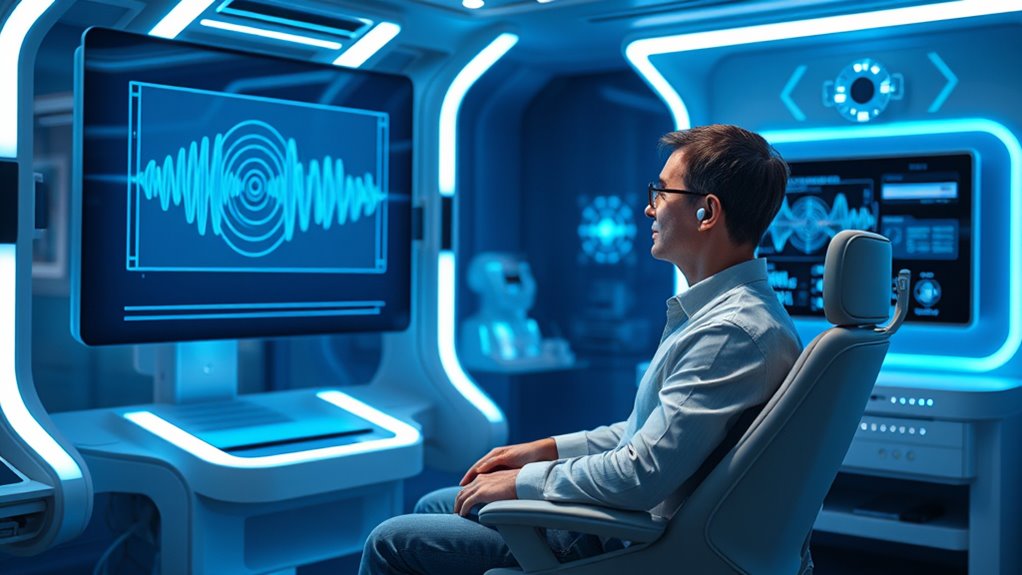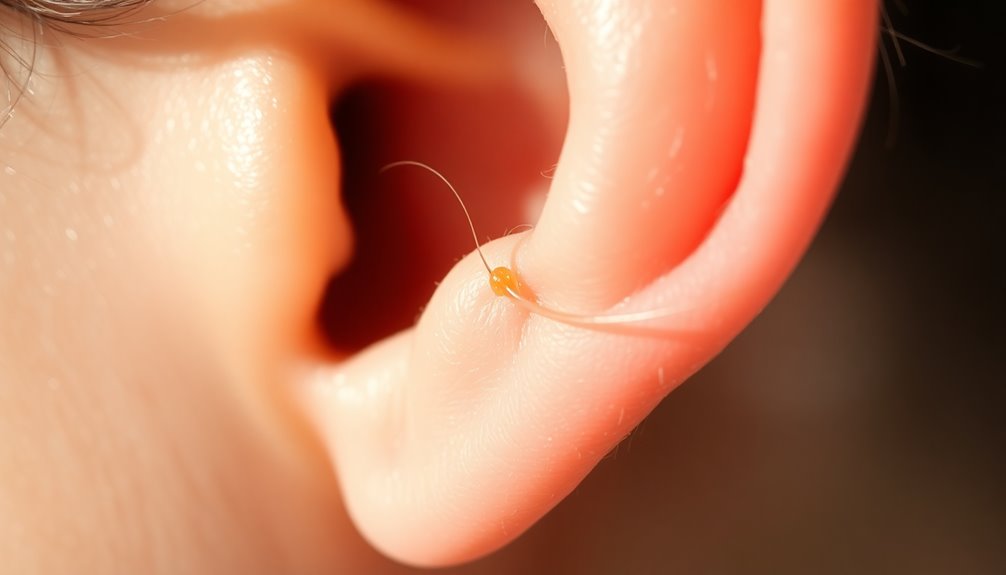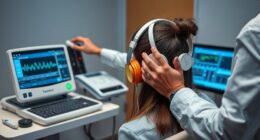In 2025, AI is revolutionizing audiology by offering faster, more accurate hearing assessments that adapt instantly to your needs. It personalizes hearing aids and cochlear implants for better clarity and comfort, even in noisy environments. AI also enables real-time monitoring, predicting hearing loss early and supporting remote care. These innovations improve diagnosis, treatment, and overall hearing experience. Keep exploring to discover how these breakthroughs can transform your hearing health journey.
Key Takeaways
- AI enables rapid, precise hearing assessments, analyzing responses in real-time and detecting subtle deficits for personalized diagnostics by 2025.
- Adaptive hearing aids and cochlear implants will dynamically tailor sound settings based on environmental and user feedback.
- Real-time environment analysis will allow devices to optimize speech clarity and background noise suppression automatically.
- AI-driven predictive models will identify early signs of hearing decline, supporting proactive intervention and personalized treatment plans.
- Remote audiology services, including teleaudiology and AI-powered virtual support, will enhance accessibility and ongoing hearing health management.
Breakthroughs in AI-Powered Hearing Tests
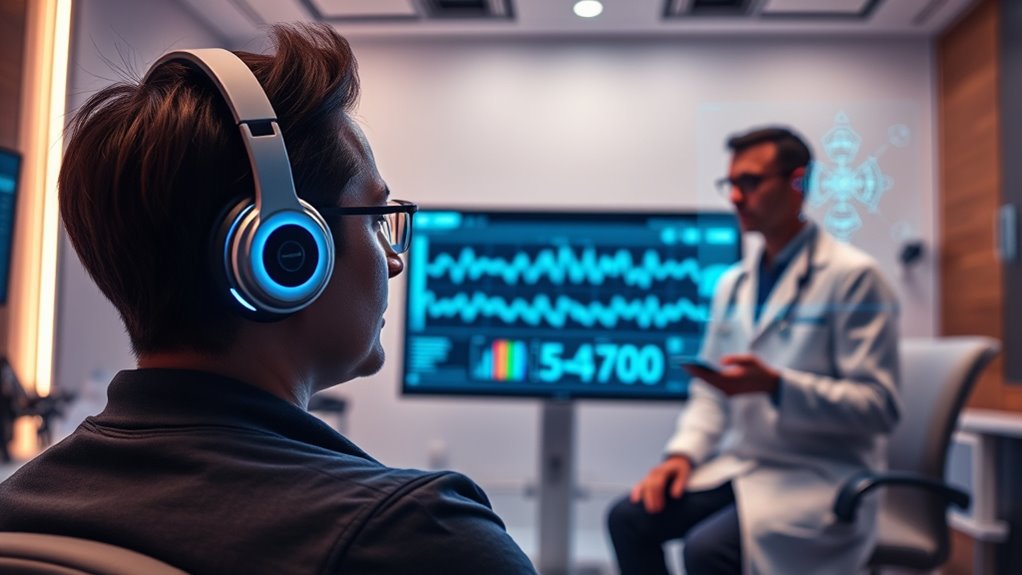
Have you ever wondered how artificial intelligence is transforming hearing assessments? AI-powered hearing tests now offer faster, more precise results. Instead of traditional methods that can be time-consuming and rely on manual interpretation, AI uses advanced algorithms to analyze your responses in real-time. These systems adapt to your hearing profile instantly, identifying even subtle deficits that might go unnoticed otherwise. They also reduce human bias and variability, ensuring consistent results across different clinics. By leveraging machine learning, these tests become smarter over time, improving their accuracy with more data. This ongoing development aligns with the broader goal of making cybersecurity measures more robust in healthcare technology. This means you get a thorough assessment quickly, often within minutes. Ultimately, AI-driven tests make hearing evaluations more accessible, reliable, and tailored to your unique needs.
Personalized Hearing Aid Fitting With Machine Learning
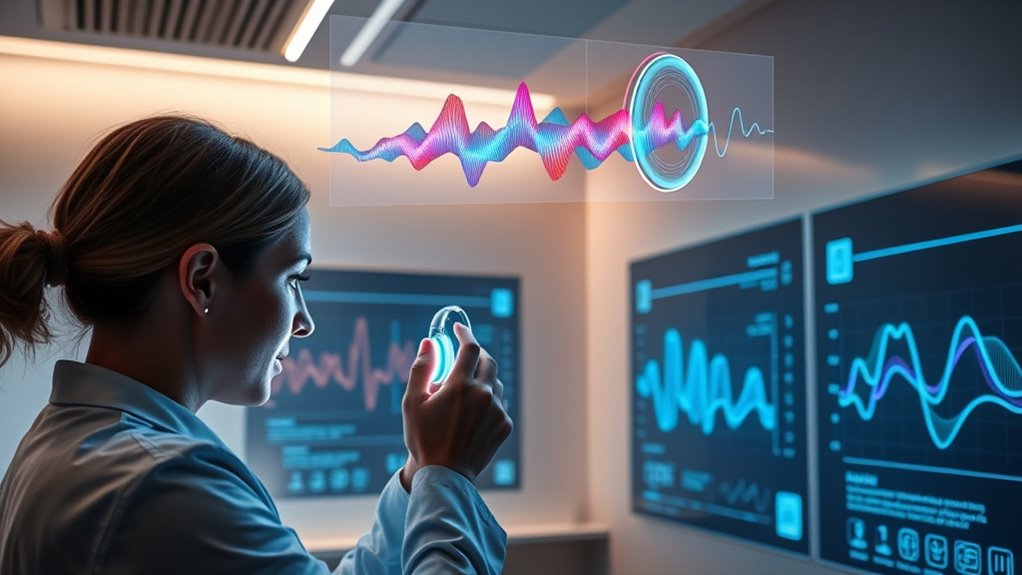
With machine learning, hearing aids can adapt sound settings to your unique needs instantly. They analyze your environment in real-time, adjusting for background noise and different listening situations. This personalized approach guarantees a more comfortable and effective hearing experience. Incorporating best practices for device customization ensures users receive optimal performance tailored to their specific preferences.
Adaptive Sound Customization
Adaptive sound customization leverages machine learning to deliver personalized hearing aid fitting that responds dynamically to each individual’s unique hearing profile. Instead of static settings, your device continuously analyzes your hearing patterns and automatically adjusts sound output for ideal clarity. This process involves collecting data about your environment and how you perceive sounds, then refining the settings to enhance speech understanding and reduce background noise. As your listening conditions change, the system adapts seamlessly, ensuring consistent comfort and performance. You don’t need to manually tweak your hearing aids; the technology does it for you in real-time. This personalized approach improves overall auditory experience, making conversations clearer and environments more comfortable without constant adjustments. Additionally, ongoing advancements in automation technologies are expected to further refine and optimize these adaptive systems.
Real-Time Environment Analysis
Building on adaptive sound customization, real-time environment analysis employs machine learning algorithms to continuously monitor and interpret your surroundings. Your hearing aids analyze soundscapes instantly, distinguishing speech from background noise and identifying specific environments like restaurants or quiet rooms. This allows the device to adapt settings on the fly, optimizing clarity and comfort without manual adjustments. As you move through different spaces, the system learns your preferences and tailors amplification accordingly. Machine learning models improve over time, becoming more accurate in predicting your needs. Energy-efficient technology can also be integrated to extend battery life and reduce power consumption. This seamless adaptation ensures you experience natural sound quality, whether you’re in a bustling street or a quiet office. Ultimately, real-time environment analysis delivers a personalized hearing experience that dynamically responds to your environment, enhancing communication and overall hearing satisfaction.
AI-Enabled Cochlear Implant Optimization

AI has revolutionized cochlear implant optimization by enabling personalized adjustments that improve hearing outcomes. By analyzing individual auditory data, AI algorithms identify the unique needs of each user, fine-tuning the implant’s settings for clarity, volume, and frequency response. This process occurs rapidly, often in real time, allowing for dynamic adjustments as you move through different environments. You’ll experience better speech understanding in noisy settings and enhanced sound quality overall. AI-driven systems also learn from your feedback and usage patterns, continuously refining the settings to suit your evolving needs. This personalized approach minimizes the trial-and-error typically involved in programming implants, leading to faster adaptation and more satisfying hearing experiences. Incorporating comfort and support solutions can further enhance overall user satisfaction by addressing physical and ergonomic considerations. Ultimately, AI-enabled optimization empowers you with more precise, adaptive, and effective cochlear implant performance.
Real-Time Diagnostic Tools and Monitoring
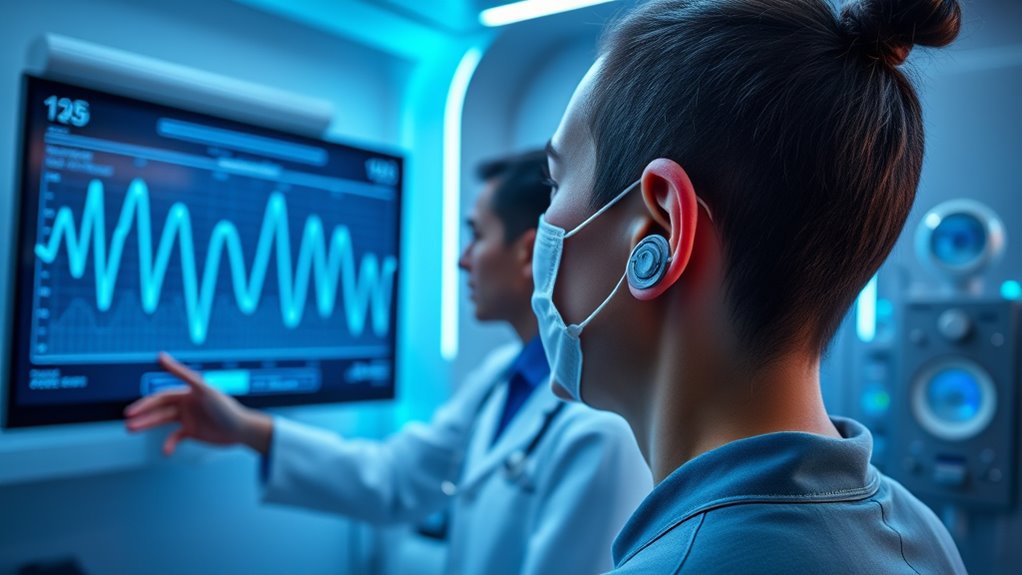
Real-time diagnostic tools and monitoring systems harness AI to provide instant insights into your hearing health. These devices continuously analyze auditory data, detecting changes or issues as they happen. When you wear a smart hearing device, AI algorithms assess sound quality, background noise, and your response, alerting you or your healthcare provider to potential problems. This immediate feedback allows for prompt adjustments, improving your hearing experience. You can also track your hearing health over time, noticing patterns or deterioration early. These tools reduce the need for frequent clinic visits, making monitoring more convenient and personalized. With AI-driven real-time diagnostics, you stay informed and proactive about your hearing health, ensuring timely interventions and better overall auditory well-being. Additionally, these systems often incorporate continuous data collection, enabling ongoing improvements in hearing device technology and personalized care plans.
Advanced Sound Processing Algorithms

Advanced sound processing algorithms are transforming how you experience hearing environments. They improve noise reduction, making speech clearer even in busy settings. These algorithms also adapt to different environments, creating personalized soundscapes tailored to your needs. Incorporating dynamic contrast ratios can further enhance the clarity and depth of audio perception, delivering a richer listening experience.
Enhanced Noise Reduction
Enhanced noise reduction relies on sophisticated sound processing algorithms that can distinguish speech from background noise more effectively. These algorithms analyze audio signals in real-time, identifying patterns typical of speech and filtering out unwanted sounds. By leveraging machine learning, they adapt to different environments, whether bustling streets or crowded restaurants, ensuring your hearing device prioritizes clear conversations. Noise reduction systems now automatically adjust their settings based on the surrounding acoustics, reducing the need for manual fine-tuning. This technology enhances speech intelligibility without sacrificing natural sound quality. With advanced filtering, you experience less listening fatigue and improved comfort, especially in noisy settings. Additionally, integrating Kia Tuning principles into sound processing can optimize performance for personalized listening experiences. Overall, enhanced noise reduction makes your hearing aids smarter, more responsive, and better at helping you focus on what matters most.
Adaptive Sound Environments
Have you ever wondered how your hearing device seamlessly adapts to different environments? Adaptive Sound Environments use advanced algorithms to analyze sounds in real-time, adjusting settings instantly. This guarantees ideal clarity whether you’re in a quiet room or noisy street. The system identifies sound sources and prioritizes speech, suppressing background noise. Machine learning models predict environment changes, enabling smooth transitions without user intervention. Here’s a quick overview: effective sound processing.
| Environment Type | Key Feature | Benefit |
|---|---|---|
| Quiet | Gentle amplification | Clear soft sounds |
| Noisy | Noise filtering and suppression | Improved speech understanding |
| Dynamic | Rapid environment detection | Seamless adjustments |
This technology makes your hearing experience natural and effortless.
Teleaudiology and Remote Care Enhancements

How is AI transforming teleaudiology and remote care? AI enables you to deliver audiological services directly to patients’ homes with greater accuracy and efficiency. Advanced algorithms analyze speech, environmental sounds, and hearing patterns in real time, guiding remote diagnostics and adjustments. AI-powered devices automatically calibrate and personalize hearing aids based on individual needs, reducing the need for frequent in-person visits. Virtual platforms now incorporate AI chatbots and virtual assistants that provide immediate support, answer questions, and triage cases. Teleaudiology workflows are becoming faster and more reliable, ensuring patients receive timely care regardless of location. Additionally, integrating AI with sound processing capabilities allows for more precise tuning and noise management in real-world environments. This evolution increases accessibility, improves outcomes, and makes remote audiology services more seamless, empowering you to deliver high-quality care beyond traditional clinical settings.
Data-Driven Hearing Loss Prediction Models
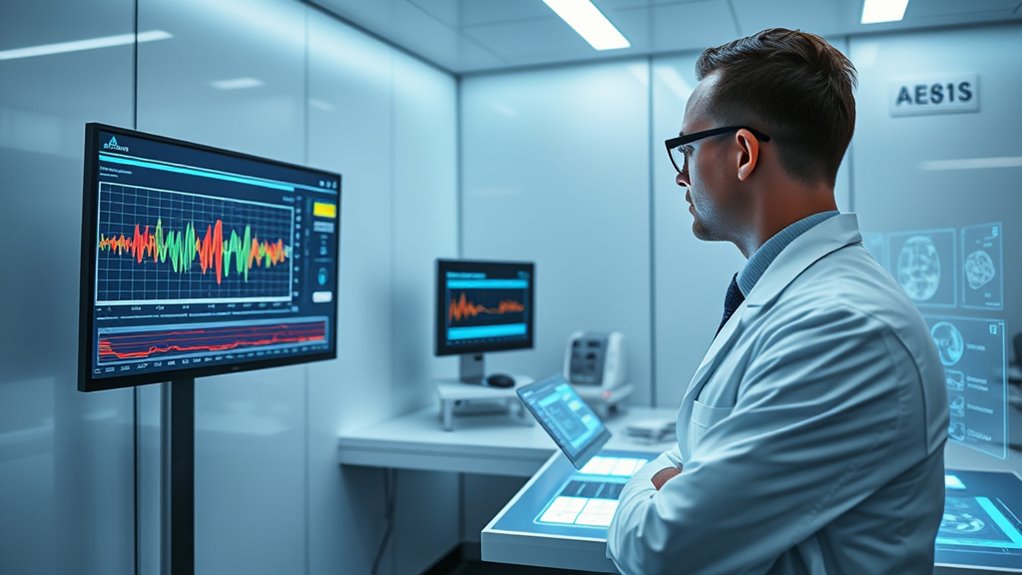
Data-driven hearing loss prediction models use advanced algorithms to identify early signs of decline, giving you a clearer picture of your auditory health. These models enable personalized treatment plans tailored to your specific needs. As a result, you can take proactive steps to preserve your hearing more effectively.
Enhanced Predictive Algorithms
Enhanced predictive algorithms are transforming audiology by enabling more accurate and early detection of hearing loss. These advanced models analyze vast amounts of data, including audiometric tests, genetic information, and environmental factors, to identify subtle patterns that signal the onset of hearing impairment. By leveraging machine learning, you can now predict hearing deterioration months or even years before symptoms become noticeable. This proactive approach allows for timely interventions, potentially slowing or preventing further loss. Additionally, enhanced algorithms continually improve as they process more data, increasing their precision over time. They also support large-scale screenings, making early detection accessible to diverse populations. Overall, these algorithms empower you with deeper insights, facilitating more effective management and better long-term outcomes for patients.
Personalized Treatment Planning
Personalized treatment planning has become more precise thanks to predictive models that analyze individual data to tailor hearing interventions. These models use your unique hearing profiles, lifestyle, and genetic information to forecast hearing loss progression and optimize solutions. Here’s how they help:
- Identify early signs of decline before symptoms appear.
- Customize hearing aid settings for your specific needs.
- Predict future hearing challenges to plan proactive care.
- Adjust treatments dynamically as your condition evolves.
Integration of AI in Audiological Research
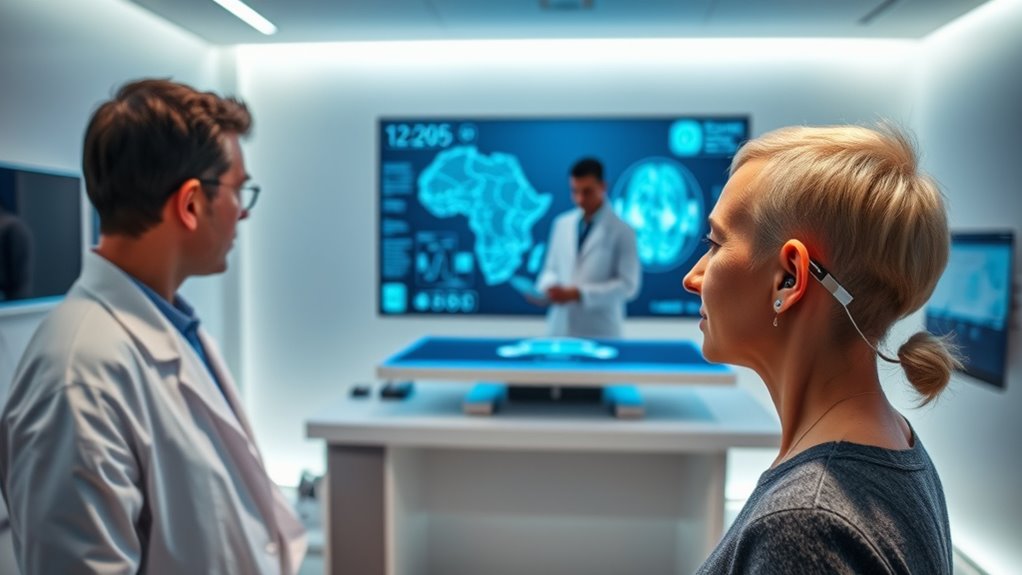
The integration of artificial intelligence into audiological research is transforming how professionals understand and diagnose hearing issues. AI algorithms analyze vast datasets from clinical tests and patient histories, revealing patterns impossible to detect manually. This accelerates research into the causes of hearing loss and identifies new biomarkers for early detection. Machine learning models help develop more accurate diagnostic tools, reducing the need for invasive procedures. You can now explore complex auditory data with greater precision, leading to insights that inform better treatment strategies. AI also enables large-scale population studies, enhancing our understanding of hearing health trends worldwide. By automating data analysis, you save time and improve research efficiency, ultimately advancing audiology as a science and improving patient outcomes.
Ethical Considerations and Data Privacy in AI Applications
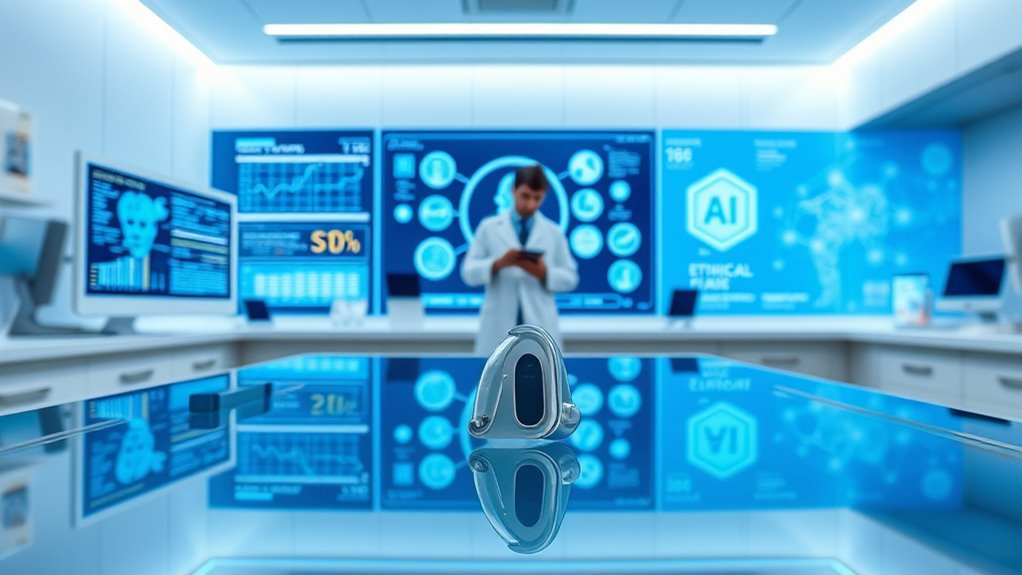
As AI becomes more integral to audiology, addressing ethical considerations and data privacy is crucial to guarantee responsible use. You need to understand that patient trust depends on transparent practices. Here are four key points to contemplate:
- Ensure data anonymization to protect patient identities.
- Obtain informed consent before collecting or using data.
- Regularly audit AI systems for bias or unfair outcomes.
- Comply with legal standards like GDPR and HIPAA.
Future Perspectives and Emerging Technologies
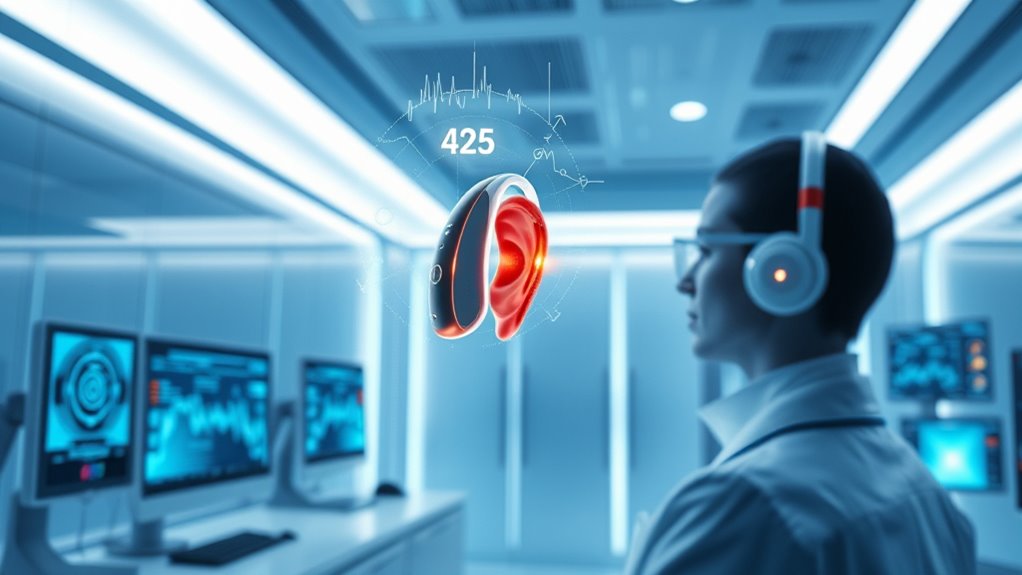
Advancements in AI are paving the way for innovative solutions that could revolutionize audiology practices. Expect emerging technologies like real-time, personalized hearing aid adjustments powered by deep learning algorithms. Wearable devices might soon continuously monitor auditory health, alerting you to early signs of hearing decline. Speech recognition will become more accurate, enabling seamless communication aids for diverse environments. Virtual reality and augmented reality could offer immersive auditory training and rehabilitation programs, tailored to individual needs. Additionally, AI-driven diagnostic tools will likely become more accessible, providing rapid, precise assessments even in remote settings. These innovations will empower you to manage hearing health proactively, improving quality of life through smarter, more adaptive audiological care. The future promises a more integrated, personalized approach to hearing wellness.
Frequently Asked Questions
How Will AI Influence Audiologist Training and Education by 2025?
You’ll see AI transforming audiologist training and education by 2025. It’ll provide personalized learning experiences, helping you master complex concepts faster. Interactive simulations and virtual patients will let you practice real-world scenarios safely. AI-powered tools will give instant feedback, improving your skills efficiently. Overall, AI will make your training more engaging, customized, and effective, preparing you better for future challenges in audiology.
What Are the Cost Implications of Ai-Driven Audiology Technologies?
Think of AI-driven audiology tech as a double-edged sword. You might see costs drop initially due to increased efficiency, but advanced AI systems can require hefty investments in software, hardware, and training. While they may save money long-term, your upfront expenses could feel like planting a seed that takes time to blossom. Ultimately, balancing these costs against improved patient outcomes and streamlined workflows is key to making smart financial decisions.
How Accessible Will AI Audiology Services Be in Rural or Underserved Areas?
You might wonder how accessible AI audiology services will be in rural or underserved areas. As technology advances, costs are expected to decrease, making these services more affordable and widespread. You’ll likely find that portable devices and telehealth options become more common, allowing you to receive quality care without traveling long distances. Overall, AI-driven audiology should become more accessible, bridging gaps in hearing health services for everyone, regardless of location.
What Regulatory Challenges Might Ai-Based Audiology Tools Face?
When it comes to AI-based audiology tools, you’re stepping into uncharted waters. Regulatory challenges could be stiff, like hitting a brick wall, because authorities need to make certain safety and efficacy. You’ll face hurdles around data privacy, approval processes, and standardization. Managing these rules takes time and patience, but it’s necessary to make sure that AI tools are reliable and trustworthy for everyone, especially in critical health care decisions.
How Will AI Impact Patient-Doctor Relationships in Audiology Care?
You might worry about AI changing how you connect with your audiologist. While AI can streamline diagnostics and personalize treatments, it could make interactions feel less personal if not managed carefully. However, if used well, AI can free up your audiologist’s time for more meaningful conversations. You’ll likely find that AI enhances trust and collaboration, making your care more effective while still maintaining the human touch you value.
Conclusion
As AI continues transforming audiology, you’ll find more precise diagnostics, personalized solutions, and real-time monitoring at your fingertips. These advancements promise better hearing health and improved quality of life. Will you embrace these emerging technologies to enhance your practice or experience? Staying informed and adaptable guarantees you stay ahead in this rapidly evolving field, ultimately empowering you to make smarter, more impactful decisions for those you serve.
